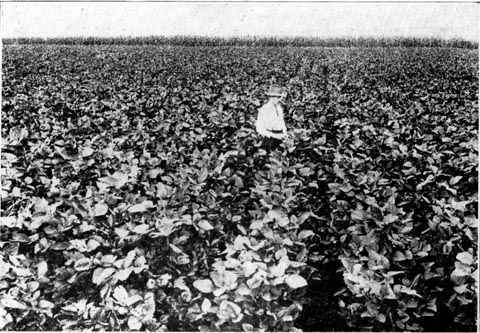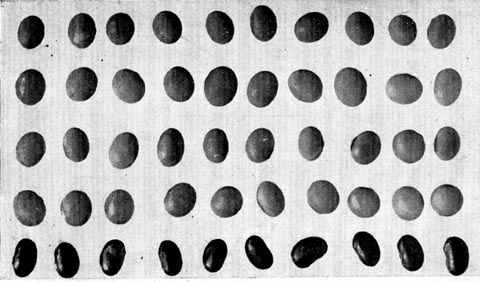
A field of Soy Beans
NEGenWeb
Resource Center
On-Line Library
|
130 |
|
supplied by a 20-bushel crop of wheat. They are too bulky and perishable for export. Their chief value lies in furnishing variety for home consumption, and in the saving of wheat made possible by their use. Potatoes are not difficult to grow. We are all familiar with their culture. The farmer who fails this year to produce at least an abundance of potatoes for his own use misses an opportunity of doing all he can to win the war.
SOY BEANSWhat I wish to say in regard to soy beans is mainly suggestion. The crop is not very familiar to most of us. I have been trying to impress the idea that we should proceed with caution with untried and unfamiliar crops. I am not receeding (sic) from this position but at the same time we should remain open minded and not overlook anything which might prove to he unusually well fitted to fill our needs.

A field of Soy Beans
The place occupied by Soy beans in protein production as indicated in the table is worthy of consideration. The digestible protein yield of a 16 bu. crop of Soy beans is almost exactly twice that yielded by a 35 bushel crop of corn. But little calculation is needed to demonstrate the value of this crop as a supplemental feed in balancing corn rations. For stock we can without doubt raise this necessary protein more economically in alfalfa. On account of the scarcity and high
|
|
131 |
price of all animal products, however, the value of the Soy bean in supplying protein for human food should not be lost sight of.Cosiderable (sic) information is now at hand in regard to the Soy bean and its culture. Nebraska Bulletin No. 10 gives the results of six years experimentation, and valuable information in regard to varieties, and the culture of the crop. Also several U. S. Department of Agriculture Bulletins in regard to this crop have recently been issued.
Here at the Lincoln station the six-year average yield of all varieties was about 14 bushels per acre.
We are without direct comparisons, but observations indicate that much of Nebraska is better adapted to the growing of Soy beans than to the growing of the ordinary garden varieties. Should this prove to be true, a valuable point in favor of Soy beans growing, is the greater ease with which they can be handled in harvesting. The pods are borne higher from the ground and there is thus less loss in cutting with a mower or any kind of a harvester which cuts above ground.

SEED OF SEVERAL SOY BEAN VARIETIES
Top row, Early Yellow; second row, S. P. I. No. 36576; third row, Habaro; fourth row, Haberlandt; bottom row, Cloud.
I would sum up, then, by saying that our crop program for the coming year should include, first, concentration on spring wheat; seconded by corn; growing an abundance of potatoes; planting winter wheat and rye next fall, and using our spare time and experimental tendencies in learning how to grow soy beans.QUESTION: What is the relative yield of the navy bean to the soy bean?
 |
 |
 |
 |
© 2002 for the NEGenWeb Project by Pam Rietsch, Ted & Carole Miller